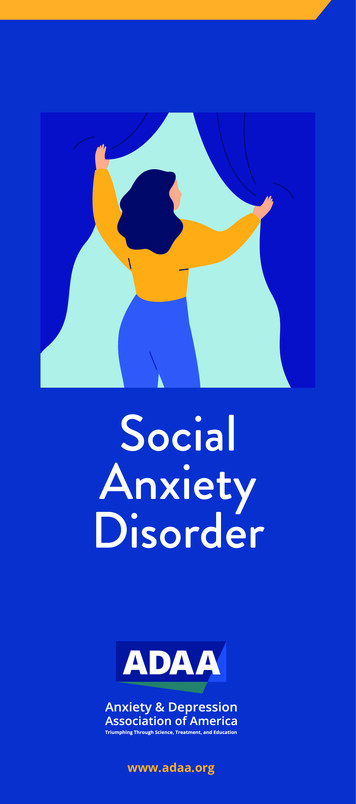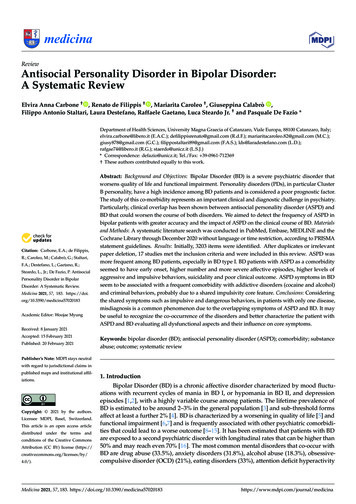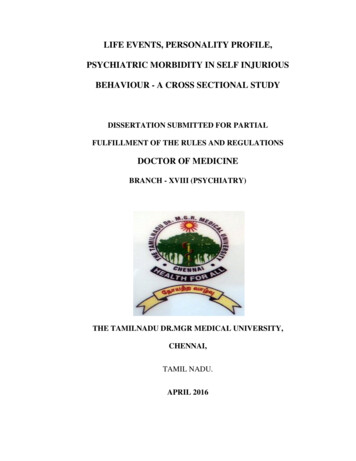
Transcription
The Spreading of DisorderKees Keizer, et al.Science 322, 1681 (2008);DOI: 10.1126/science.1161405The following resources related to this article are available online atwww.sciencemag.org (this information is current as of December 19, 2008 ):Supporting Online Material can be found 405/DC1A list of selected additional articles on the Science Web sites related to this article can befound 5908/1681#related-contentThis article appears in the following subject /collection/sociologyInformation about obtaining reprints of this article or about obtaining permission to reproducethis article in whole or in part can be found Science (print ISSN 0036-8075; online ISSN 1095-9203) is published weekly, except the last week in December, by theAmerican Association for the Advancement of Science, 1200 New York Avenue NW, Washington, DC 20005. Copyright2008 by the American Association for the Advancement of Science; all rights reserved. The title Science is aregistered trademark of AAAS.Downloaded from www.sciencemag.org on December 19, 2008Updated information and services, including high-resolution figures, can be found in the onlineversion of this article 5908/1681
changes in the statistics of PDF orientations, amaximum shock attenuation of 5 GPa seems tobe the more realistic value.The percentage of shocked quartz grains andthe number of PDF sets per grain are more sensitive indicators of minor changes in shock pressure than pure PDF orientation statistics. Thecombination of detailed petrographic investigation and numerical modeling indicates that bothof these approaches are essential to reconstruct thepreimpact position of rocks and to characterizeproperly the shock pressure distribution at thescale of an impact structure. Our observationssuggest that, in the case of the 10.5-km-diameterBosumtwi impact structure, the uppermost rocksof the central uplift experienced shock pressuresbelow 30 GPa, whereas pressures up to 40 to45 GPa were recorded for the about-four-timeslarger Puchezh-Katunki impact structure (15).Shock attenuation in the uppermost part of a central uplift has been, for the first time, constrained bydetailed shock degree profiling at the microscale.Numerical modeling of this section of the centraluplift has then established where this section of thecentral uplift was located before uplift formation,which was only possible once the shock regimehad been established by micropetrography. Theresults imply that, for moderately sized impactcraters, the rise of the central uplift is dominatedby brittle failure, whereas in the case of largerimpact structures, and also depending on rockproprieties, the uplifted, relatively stronger shockedrocks may behave in a more ductile manner.References and Notes1. D. Stöffler, Fortschr. Mineral. 49, 50 (1972).2. D. Stöffler, F. Langenhorst, Meteorit. Planet. Sci. 29, 155 (1994).3. R. A. F. Grieve, F. Langenhorst, D. Stöffler, Meteorit.Planet. Sci. 31, 6 (1996).4. R. A. F. Grieve, Annu. Rev. Earth Planet. Sci. 15, 245 (1987).5. H. J. Melosh, Impact Cratering: A Geological Process(Oxford Univ. Press, New York, 1989).6. J. T. Cherry, F. L. Petersen, in Peaceful Nuclear Explosions(International Atomic Energy Agency, Vienna, 1970),pp. 241–325.7. T. J. Ahrens, J. D. O’Keefe, in Impact and ExplosionCratering, D. J. Roddy, R. O. Pepin, R. B. Merrill, Eds.(Pergamon, New York, 1977), pp. 639–656.8. N. K. Mitani, J. Geophys. Res. 108, 5003 (2003).9. P. B. Robertson, R. A. F. Grieve, in Impact and ExplosionCratering, D. J. Roddy, R. O. Pepin, R. B. Merrill, Eds.(Pergamon, New York, 1977), pp. 687–702.10. R. A. F. Grieve, P. B. Robertson, Contrib. Mineral. Petrol.58, 37 (1976).11. L. V. Sazonova, N. N. Karotaeve, G. Y. Ponomarev,A. I. Dabizha, in Impactites, A. A. Marakushev, Ed.(Moscow State Univ., Moscow, 1981), pp. 93–133.12. R. A. F. Grieve, J. M. Coderre, P. B. Robertson,J. Alexopoulos, Tectonophysics 171, 185 (1990).13. V. I. Fel’dman, L. V. Sazonova, S. I. Kotel’nikov,Dokl. Akad. Nauk SSSR 349, 658 (1996).14. B. O. Dressler, V. L. Sharpton, B. C. Schuraytz,Contrib. Mineral. Petrol. 130, 275 (1998).15. V. L. Masaitis, L. A. Pevzner, Deep Drilling in the ImpactStructure: Puchezh-Katunki, Russia (VSEGEI, St. Petersburg,1999).16. R. L. Gibson, W. U. Reimold, Geol. Soc. Am. Spec. Pap.384, 329 (1996).17. C. Koeberl, W. U. Reimold, Yearb. Austrian Geol. Surv.145, 31 (2005).18. C. Koeberl et al., Meteorit. Planet. Sci. 42, 483 (2007).19. L. Ferrière, C. Koeberl, W. U. Reimold, Meteorit. Planet. Sci.42, 611 (2007).20. L. Coney, R. L. Gibson, W. U. Reimold, C. Koeberl,Meteorit. Planet. Sci. 42, 569 (2007).The Spreading of DisorderKees Keizer,* Siegwart Lindenberg, Linda StegImagine that the neighborhood you are living in is covered with graffiti, litter, and unreturnedshopping carts. Would this reality cause you to litter more, trespass, or even steal? A thesis knownas the broken windows theory suggests that signs of disorderly and petty criminal behavior triggermore disorderly and petty criminal behavior, thus causing the behavior to spread. This may causeneighborhoods to decay and the quality of life of its inhabitants to deteriorate. For a citygovernment, this may be a vital policy issue. But does disorder really spread in neighborhoods?So far there has not been strong empirical support, and it is not clear what constitutes disorderand what may make it spread. We generated hypotheses about the spread of disorder andtested them in six field experiments. We found that, when people observe that others violated acertain social norm or legitimate rule, they are more likely to violate other norms or rules, whichcauses disorder to spread.n the mid-1990s, the mayor of New York andhis police commissioner adopted a “Qualityof life campaign.” Attention was focused onfighting signs of disorder and petty crime. Graffitiwas removed, streets were swept, and signs ofvandalism were cleared. This initiative was basedon the broken windows theory (BWT) of Wilsonand Kelling (1). The BWT suggests that signs ofIFaculty of Behavioral and Social Sciences, University of Groningen, 9712 TS Groningen, Netherlands.*To whom correspondence should be addressed. E-mail:K.E.Keizer@rug.nldisorder like broken windows, litter, and graffitiinduce other (types of) disorder and petty crime(2). It was thought that removing these signs ofdisorder would take away an important trigger ofdisorderly and petty criminal behavior. After theintroduction of the campaign, petty crime rates inNew York dropped. Since then, approaches basedon the BWT have become popular and have beenadopted worldwide (e.g., in various cities in theUnited States, Great Britain, Netherlands, Indonesia,and South Africa).BWT may be very popular, but it is alsohighly controversial. So far, it lacks empiricalwww.sciencemag.orgSCIENCEVOL 32221. C. A. Scholz et al., Geology 30, 939 (2002).22. Materials and methods are available as supportingmaterial on Science Online.23. F. Hörz, in Shock Metamorphism of Natural Materials,B. M. French, N. M. Short, Eds. (Mono, Baltimore, 1968),pp. 243–253.24. A. R. Huffman, W. U. Reimold, Tectonophysics 256, 165(1996).25. B. M. French, Traces of Catastrophe: A Handbook ofShock-Metamorphic Effects in Terrestrial Meteorite ImpactStructures [LPI Contribution No. 954, Lunar and PlanetaryInstitute (LPI), Houston, TX, 1998].26. B. Ivanov, Sol. Syst. Res. 39, 381 (2005).27. M. J. Cintala, R. A. F. Grieve, Meteorit. Planet. Sci. 33,889 (1998).28. E. Pierazzo, A. M. Vickery, H. J. Melosh, Icarus 127, 408(1997).29. Drilling was funded by ICDP, NSF, the Austrian Fonds zurFörderung der wissenschaftlichen Forschung (FWF), theCanadian Natural Sciences and Engineering ResearchCouncil, and the Austrian Academy of Sciences. We thankDOSECC (Drilling, Observation and Sampling of theEarth’s Continental Crust) for the drilling operations. Thiswork was supported by the Austrian FWF (grants P17194N10 and P18862-N10) and the Austrian Academy ofSciences. B.A.I. was supported by the Russian Foundationfor Basic Science (RFBR grant 08-05-00908-а), andW.U.R.’s research is supported by the German ScienceFoundation (Deutsche Forschungsgemeinschaft) andHumboldt University of Berlin.Supporting Online 08/1678/DC1Materials and MethodsSOM TextFigs. S1 to S4Tables S1 to S4References23 September 2008; accepted 10 November 200810.1126/science.1166283support, and it fails to specify what constitutesdisorder. Studies aimed to test the BWT (3–6)have provided mixed results at best. The NationalResearch Council (NRC) concluded that the research did not provide strong support for the BWT(7). There is also little evidence that broken window policing contributed to the sharp decrease inpetty crime in New York (8–10). Moreover, to ourknowledge, research on the BWT has so far beencorrelational, so conclusions about causality areshaky (6, 8). The BWT suggests that a setting withdisorder triggers disorderly and petty criminal behavior, but it might be the other way around or bothmay be caused by a third variable. Furthermore, theBWT gives no insight into what is and what is nota condition of disorder that will spread. Because theBWT forms the backbone of many cities’ defenseagainst the growing threat of disorder and pettycrime, these shortcomings need to be addressed.In the present study, we conducted six fieldexperiments that address these issues. Our firststep was to conceptualize a disorderly setting insuch a way that we can link it to a process ofspreading norm violations. Social norms refer either to the perception of common (dis)approvalof a particular kind of behavior (injunctive norm)or to a particular behavior common in a setting(descriptive norm) (11–16). Injunctive norms affect behavior because they provide informationabout which behavior is most appropriate in a12 DECEMBER 2008Downloaded from www.sciencemag.org on December 19, 2008REPORTS1681
REPORTS1682ingly did (or do) not pursue the goal to act appropriately. In turn, a weakening of this goalstrengthens conflicting hedonic and gain goals.For example, when people observe that othershave painted graffiti where it should not havebeen painted, they actually observe inappropriatebehavior. This, we predict, weakens their concernfor appropriateness and strengthens the goal to dowhat makes them feel good (for example, by beinglazy and throwing paper on the street) or the goalto gain resources (say by stealing). Thus peopledon’t necessarily copy the inappropriate behaviorthey observe but let concerns other than appropriateness take center stage. In this way, one normviolation fosters violations of other norms, anddisorder spreads from one kind of inappropriatebehavior to other kinds. We call this the crossnorm inhibition effect. An important implicationof this “goal-framing” theory for the BWT is thatthe effect should not be limited to social norms inthe strict sense of the word but would also applyto all sorts of legitimate rules, such as laws, policeordinances, or even legitimate rules establishedby private companies.To test this theory, we conducted controlledfield experiments in common public spaces (34),that is, in locations where ordinary “brokenwindow” kind of disorder could be observed.Downloaded from www.sciencemag.org on December 19, 2008given situation [e.g., (17–19)]. For example, theantilitter norm is a widely held injunctive norm[e.g., (20, 21)]. The extent to which an injunctivenorm affects behavior depends on how much thenorm is on people’s mind (22, 23). For example,an antilitter norm will be more on people’s mindswhen they see someone picking up a piece oflitter (which shows disapprovement of littering)(12) or simply see a norm stated on a sign (24, 25).Descriptive norms affect behavior because theyprovide information about which behavior is mostcommon in a given situation. For example, a littered setting shows that it is common to litter andwill therefore enhance littering (11, 26, 27). Similar to injunctive norms, the more conspicuous thedescriptive norm, the more strongly it influencesbehavior. For example, the probability that a participant litters in a littered setting is enhanced whena lot of litter is present or when the participantwatches someone littering (11). Injunctive anddescriptive norms can be in conflict, as for example in a setting where it is common to littereven though littering is commonly disapprovedof. Thus, settings described in BWT as disorderly(e.g., a littered setting) can be conceptualized assettings in which descriptive and injunctive normsare in conflict. The next question then is howbehavior is influenced by such a setting.Injunctive-norm information in a persuasivemessage is more effective when accompaniedby descriptive norm information that is in alignment rather than in conflict with that message(24, 28–30). For example, a sign drawing attention to the antilitter norm is more influential inreducing littering when placed in a nonlitteredsetting than when it is placed in a prelitteredsetting (31). Thus, a setting with graffiti, describedby the BWT as a setting showing disorder, cancause the spraying of graffiti because it inhibitsthe injunctive antigraffiti norm. In honor of theindividual who first described this process, wecall this the Cialdini effect. The important question for the BWT is whether or not it also causesdisorderly (or petty criminal) behavior in general.The question we will address is the following: Domore people litter or even steal in a setting wherethe antigraffiti norm (injunctive norm) is in conflict with the descriptive norm (setting shows it iscommon to spray graffiti)?The Cialdini effect has its basis in people’stendency to reason “if a lot of people are doingthis, it’s probably a wise thing to do” and to dowhat they observe others are doing (32) However, we believe that there is another, goal-drivenmechanism at work as well, which is particularlyimportant for the spread of disorder. Much conformity to injunctive norms is the result of peoplepursuing the goal to act appropriately. However,people can also pursue a hedonic goal directed atfeeling better right now or a gain goal directed atguarding and improving one’s resources. All threegoals can be in conflict, and the weakening of oneis likely to bring another goal to the fore (33). Ina given situation, the goal to act appropriately isweakened when people observe that others seem-Fig. 1.12 DECEMBER 2008VOL 322SCIENCEwww.sciencemag.org
Participants were people in the public spacejudged to be 18 years or older. There were nosigns in any of the studies that they were aware ofbeing observed by the experimenter. We distinguished between a contextual norm (which theparticipant witnessed having been violated) and atarget norm (a violation committed by the participant).What we manipulated were the indicationsthat the contextual norm was being violated. Whatwe observed as a dependent variable was the relative number of individuals who then violated thetarget norm, which was inconvenient or costlyto follow in this situation. We predicted thatdisorder (violation of contextual norm) wouldspread (violation of target norm). To study therobustness of this cross-norm inhibition effect,we conducted six different studies. For ease ofdescription, let us call the situation in which thecontextual norm is violated (i.e., inappropriatebehavior by others is being displayed) the disorder condition and the one in which it is notviolated the order condition. Other factors possibly influencing the results were kept constantbetween conditions (no signs of other norm orrule violations, same weather conditions, andsame period of the day). A confederate postedout of sight observed whether participants didor did not violate the target norm. Gender wascoded at first but turned out not to have anyimpact on the results and was dropped in laterexperiments. The arrangements in all experimentswere such that it was virtually impossible forpeople not to notice the violations of injunctivenorms (such as graffiti, wrongly parked bicycles, and firecrackers).In study 1, the setting was an alley in Groningen located in a shopping area and commonlyused to park bicycles. In the order condition, thewalls of the alley were clean (Fig. 1A), whereasin the disorder condition they were covered withgraffiti (Fig. 1B). A standard prohibition sign (around red sign with a round white center) withFig. 2.Fig. 3.www.sciencemag.orgSCIENCEVOL 322the text “Graffiti” pointed out the disapprovedbehavior. The sign was highly noticeable, andevery subject entering the setting at least glancedat it. Participants (N 77 in each condition) wereall people who came to collect their parked bicycles. In their absence, a flyer with an elasticband had been attached to the handlebar of theirbicycle. The flyer was white and thus very noticeable. It read: “We wish everybody happy holidays,” signed with the name of a nonexistentsportswear shop. The flyer had to be removed bythe participant to easily use the handlebar. Because there were no trash cans in the alley, “notlittering” meant taking the flyer with them. Wecounted throwing the flyer on the ground or hanging it on another bicycle as littering.The cross-norm inhibition effect of violatingthe antigraffiti norm on littering was quite substantial. Of the participants in the order condition(nongraffiti), 33% littered compared with 69% ofthe participants in the disorder condition (graffition the walls). The difference is highly significant[c2(1, 154) 20.367, P 0.001]. In Groningen,littering is generally tolerated by the police sothat the effect could not be explained by a guesson law enforcement, such as “if people haven’tbeen caught painting graffiti, I will not be caughtdropping paper.”We designed the next studies to include avariety of norms in order to address two questions. We wanted to determine whether the crossnorm inhibition effect was restricted to generallyaccepted social norms or whether, as expected bythe goal-framing theory, it also extended to localordinances by the police or even to normativerequests set up by private companies. We alsowanted to determine how far the influence wouldgo. In other words, would a norm violation justaffect relatively light infractions, such as littering,or would it go so far as to affect the willingness toviolate such serious norms as “thou shalt not steal”?For study 2, we used a police ordinance as acontextual norm and “no trespassing” (as orderedby the police) as the target norm in the setting of acar park. Thus, both contextual and target normswere not general social norms but rules set up bythe local police for a particular local situation. Atemporary fence (set up by us) closed off the mainentrance for people who came to pick up their car,but a gap of about 50 cm was left open in thefence (Fig. 2). We attached two signs to the temporary fence just 60 cm apart and directly next tothe gap. The right sign (our contextual norm) indicated that it was prohibited to lock bicycles tothe fence. The left sign (our target norm) madeclear that it was prohibited to use this entranceand that people had to use an alternative entranceto the car park, which required walking a 200-mdetour. In the order condition, four bicycles standing 1 m before the fence were ostensibly notlocked to the fence.In the disorder condition, four bicycles werelocked to the fence for everyone to see. The dependent variable was whether pedestrians conformed to the “no throughway” sign (the target12 DECEMBER 2008Downloaded from www.sciencemag.org on December 19, 2008REPORTS1683
norm) and walked the 200-m detour to the temporary entrance that was pointed out by the sign.Violating the “no throughway” ordinance meantstepping through the gap in the fence. Subjects (N 44 in the order condition and N 49 in the disorder condition) were all people who came to collect their car from the car park. A group of peopleapproaching the fence was counted as one subject.Again there was a clear cross-norm inhibitioneffect. Of the participants in the order condition(where bicycles were not locked to the fence),27% stepped through the gap in the fence, compared with 82% of the participants in the disordercondition (where the bicycles were attached to thefence). The difference is significant [c2(1, 93) 27.791, P 0.001].Would this also hold for a rule set by a privatecompany that is not enforced with sanctions? Instudy 3, a parking garage adjacent to a supermarket and health club was used in which the contextual norm established by the private companyis to return shopping carts to the supermarketafter loading groceries into one’s car. A very visible sticker with the text: “please return yourshopping carts” attached to the entrance doors ofthe parking garage focused attention on this normative request (Fig. 3). In the order condition, thegarage was clear of shopping carts that were notreturned. In the disorder condition, there werefour unreturned shopping carts standing aroundin disarray. The (unreturned) carts used in the disorder condition had no coin deposit system, sopeople were not financially encouraged to returnthem. To discourage people who just arrived fromusing the shopping carts and thus removing thedisorder, we smeared the handle bars of the cartswith petroleum jelly. Participants (N 60 in eachcondition) were visitors of the supermarket and ahealth club who came to collect their car from themultilevel parking garage. Only people not usinga shopping cart were included. The target normwas the anti-litter norm, already used in study 1.The dependent variable was whether or not participants who returned to their car littered a flyer(the same flyer as used in study 1) that was placedunder the driver’s side windshield wiper of theirparked car. The results show that even with thisprivate request, a considerable cross-norm inhibition effect could be observed. Of the participantsin the condition without shopping carts, 30% littered the flyer, compared with 58% of the participants in the condition for which unreturned shoppingcarts were present. The difference is significant[c2(1, 120) 9.766, P 0.002].Is disorder only linked to visual cues of normviolation? Would the cross-norm inhibition effectbe of any influence when the contextual normwas merely audible? In our fourth study, we focused on a national law as a contextual norm. InNetherlands it is prohibited by law (with a 60fine) to set off fireworks in the weeks before NewYear’s Eve. We wanted to find out, 2 weeks before New Year’s Day, whether an offense againstthis national law would induce people to litter. Incontrast to studies 1 to 3, the contextual norm wasnot made conspicuous (say by a sign stating thelaw). The law about fireworks is well known, andits violation itself would immediately make thelaw salient in people’s mind. The setting we usedwas a bicycle shed located near a busy train station. The subjects (N 50 in the order conditionand N 46 in the disorder condition) were allpeople who came to collect their parked bicycle.In the order condition, there was no sound offireworks. In the disorder condition, we set offfirecrackers (well within hearing distance of theparticipants but out of sight to prevent any visualcues). We observed whether participants littered aFig. 4.168412 DECEMBER 2008VOL 322SCIENCEflyer (the same flyer as used in studies 1 and 3)attached to the handlebar of their bicycle. Of thesubjects in the order condition (no fireworks setoff), 52% littered the flyer compared with 80% ofthe subjects that heard fireworks being set off asthey entered the bicycle shed. The difference issignificant [c2(1,96) 8.587, P 0.003].For studies 5 and 6, the target norm wasstealing, and we examined whether an envelope,visibly containing a 5 note and hanging out of amailbox, would be stolen more often if a contextual norm was violated. The white (addressed)window envelope sticking out of a mailbox (situated in Groningen) was very noticeable for everyone approaching the mailbox, and it was clearlyvisible that the envelope contained a 5 note (Fig.4). The participants were all people who singlypassed the mailbox on foot (and the few whoactually posted a letter). We conducted a baselineorder condition (N 71) in which the mailbox wasnot covered with graffiti and the ground around themailbox was clean. We then conducted twodisorder conditions: one in which the mailboxwas covered with graffiti without litter on theground (N 60, study 5) and one in which therewas no graffiti on the mailbox but the space aroundthe mailbox was littered (N 72, study 6). Thecircumstances of all three conditions in term ofperiod of the day and weather were held constant.The dependent variable was whether or not peoplewould steal the envelope. Leaving the envelope orpushing it into the mailbox was considered notstealing. Opening the envelope or taking it wasconsidered stealing. Thus, we compared twodisorder conditions to the baseline condition.The study 5 results were quite dramatic. Ofthe participants in the baseline order condition(no graffiti, no littering), 13% stole the envelope compared with 27% of the subjects in thegraffiti disorder condition. The difference is significant [c2(1, 131) 4.122, P 0.035].The results of study 5 proved to be robust.Compared with the baseline order condition (inwhich 13% stole the envelope), 25% of the subjects in study 6 stole the envelope in the litterdisorder condition. The difference is again significant [c2(1, 143) 3.545, P 0.047]. It is highlyunlikely that this effect is due to a guess about thelikelihood of law enforcement triggered by littering. People are not likely to infer a low likelihoodof law enforcement against stealing from the factthat people littered the street, because in Groningenlittering is generally tolerated by the police whereasstealing is not. The most likely interpretation ofthese results is, as before, that one disorder (graffitior littering) actually fostered a new disorder (stealing)by weakening the goal of acting appropriately.Our conclusion is that, as a certain normviolating behavior becomes more common, it willnegatively influence conformity to other normsand rules. The effect was not limited to socialnorms but also applied to police ordinances andeven to legitimate requests established by privatecompanies. The mere presence of graffiti morethan doubled the number of people littering andwww.sciencemag.orgDownloaded from www.sciencemag.org on December 19, 2008REPORTS
stealing. There is a clear message for policymakers and police officers: Early disorder diagnosis and intervention are of vital importancewhen fighting the spread of disorder. Signs ofinappropriate behavior like graffiti or broken windows lead to other inappropriate behavior (e.g.,litter or stealing), which in turn results in the inhibition of other norms (i.e., a general weakeningof the goal to act appropriately). So once disorderhas spread, merely fixing the broken windows orremoving the graffiti may not be sufficientanymore. An effective intervention should nowaddress the goal to act appropriately on all fronts.References and Notes1. J. Q. Wilson, G. L. Kelling, “Broken windows,” Atl. Mon.(March 1982), p. 29.2. M. Gladwell, The Tipping Point: How Little Things CanMake a Big Difference (Little, Brown, Boston, 2000).3. W. G. Skogan, Disorder and Decline: Crime and the Spiralof Decay in American Neighborhoods (Univ. of CaliforniaPress, Berkeley, 1990).4. G. Kelling, C. Coles, Fixing Broken Windows: RestoringOrder and Reducing Crime in Our Communities(Free Press, New York, 1996).5. G. L. Kelling, W. H. Sousa Jr., Do Police Matter? AnAnalysis of the Impact of New York City’s Police Reforms(Manhattan Institute Center for Civic Innovation CivicReport No. 22, New York, 2001).6. R. J. Sampson, S. W. Raudenbush, Am. J. Sociol. 105,603 (1999).7. National Research Council, Fairness and Effectiveness inPolicing: The Evidence, W. Skogan, K. Frydl, Eds.(National Academies Press, Washington, DC, 2004).8. B. E. Harcourt, Mich. Law Rev. 97, 291 (1998).9. J. E. Eck, E. R. Maguire, in The Crime Drop in America,A. Blumstein, J. Wallman, Eds. (Cambridge Univ. Press,New York, 2000), pp. 207–265.10. B. E. Harourt, J. Ludwig, Univ. Chic. Law Rev. 73, 271(2006).11. R. B. Cialdini, R. R. Reno, C. A. Kallgren, J. Pers. Soc.Psychol. 58, 1015 (1990).12. R. B. Cialdini, C. A. Kallgren, R. R. Reno, Adv. Exp. Soc.Psychol. 24, 201 (1991).13. R. B. Cialdini, Influence: The Psychology of Persuasion(Morrow, New York, ed. 2, 1993).14. J. P. Codol, Eur. J. Soc. Psychol. 5, 457 (1975).15. J. M. Marques, D. Abrams, D. Páez, C. Martinez-Taboada,J. Pers. Soc. Psychol. 75, 976 (1998).16. L. S. Shaffer, J. Mind Behav. 4, 275 (1983).17. S. Chaiken, R. Giner-Sorolla, S. Chen, in The Psychologyof Action: Linking Motivation and Cognition to Behavior,P. M. Gollwitzer, J. A. Bargh, Eds. (Guilford, New York,1996), pp. 553–578.18. R. B. Cialdini, M. R. Trost, in Handbook of Social Psychology,D. Gilber, S. Fiske, G. Lindzey, Eds. (McGraw-Hill, Boston,ed. 4, 1998), vol. 2, pp. 151–192.19. M. Deutsch, H. B. Gerard, J. Abnorm. Soc. Psychol. 51,629 (1955).20. L. Berkowitz, Adv. Exp. Soc. Psychol. 6, 63 (1972).21. L. Bickman, Soc. Psychol. 87, 323 (1972).Germ Cell–Intrinsic and –ExtrinsicFactors Govern Meiotic Initiation inMouse EmbryosYanfeng Lin,* Mark E. Gill,* Jana Koubova, David C. PageRetinoic acid (RA) is an essential extrinsic inducer of meiotic initiation in mammalian germcells. However, RA acts too widely in mammalian development to account, by itself, forthe cell-type and temporal specificity of meiotic initiation. We considered parallels to yeast, inwhich extrinsic and intrinsic factors combine
shopping carts. Would this reality cause you to litter more, trespass, or even steal? A thesis known as the broken windows theory suggests that signs of disorderly and petty criminal behavior trigger more disorderly and petty criminal behavior, thus causing the behavior to spread. This may cause










